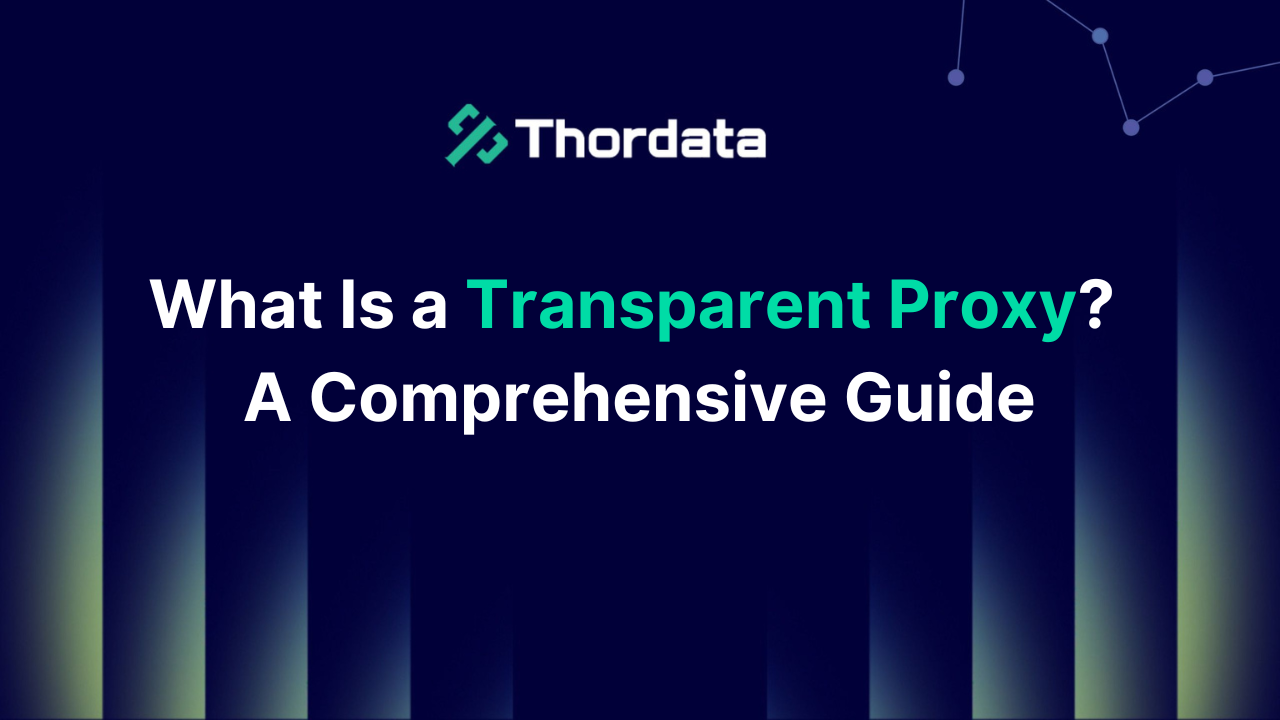What Is a Transparent Proxy? A Comprehensive Guide


Although transparent proxy is invisible, it still profoundly influences modern network communication. It is widely used for optimizing network performance, implementing traffic management, and enhancing content filtering. Transparent proxies automatically forward network traffic, providing convenient solutions for businesses, schools, and Internet Service Providers (ISPs). This article will take you deep into the world of transparent proxies.
The Definition of Transparent Proxies
A transparent proxy, also known as an inline proxy, forced proxy, implicit proxy, or intercepting proxy. Users may not notice while using it because it does not alter the user’s requests or the responses from the target server.
Transparent proxies typically retain the user’s real IP address. And the target server can see the user’s original IP information.
The Core Process of Transparent Proxies
1.The transparent proxy is between the user and the target server, usually deployed in gateways, routers, or firewalls.
2.The transparent proxy intercepts the user’s request, with the user unaware of it.
3.The transparent proxy checks if the request content is already in its cache. If it exists, it returns the cached data directly without making a request to the target server. If the data is not in the cache, the proxy forwards the request to the target server.
4.Once the target server receives the request, it returns response data to the transparent proxy.
Finally, the transparent proxy sends the response back to the user. The user typically does not realize that the traffic is passing through the proxy.
Applications of Transparent Proxies
1.Network Monitoring and Traffic Management
The transparent proxy can record the content and timing of user visits for auditing and analysis purposes.
Restricts access to specific websites. It is commonly used by businesses to monitor abnormal traffic or potential threats.
2.Load Balancing
Distributes requests to different backend servers based on their load.
Enhances service availability and access performance. It plays a significant role in Content Delivery Networks, accelerating access to static resources, and reducing server load.
3.Content Caching and Acceleration
Reduces network bandwidth consumption and accelerates user access speeds. Proxy servers cache frequently visited content (e.g., web pages, images, videos).
Advantages of Transparent Proxies
1.Cache Acceleration
Transparent proxies can accelerate network speed and save bandwidth. By caching commonly used resources (e.g., web pages, images, videos),It to improve the user experience.
2.Traffic Monitoring
It enables real-time monitoring and logging of network traffic for behavioral analysis and network optimization. Administrators can easily access traffic reports and user access logs.
3.Content Filtering Support
Can filter web content based on specific rules (e.g., keywords, URLs, types), blocking access to undesirable websites. Schools, and government networks are commonly use it. It can enhances network security and compliance.
4.Load Balancing
Distributes user requests across multiple backend servers to prevent overload, enhancing system performance and availability.
Disadvantages of Transparent Proxies
1.Insufficient Privacy Protection
Does not hide the user’s real IP address, and the target server can view the actual IP. The user’s traffic may be monitored or recorded by the proxy server, posing a privacy risk.
2.Security Issues
If configured incorrectly, a transparent proxy can become a target for malicious attacks, leading to data tampering or theft. Incorrect configuration may significantly reduce security defenses rather than enhance them. Using a transparent HTTPS proxy can be risky, and services like online banking may not allow this setup.
3.Potential Performance Impact
Proxy servers need to handle a large volume of traffic. If the caching mechanism is inefficient, it may cause delays or errors in data return.
4.Deployment and Maintenance Costs
Deploying a transparent proxy requires configuration of routers, firewalls, or gateways. So it may require professional technical support.
Common Settings for Transparent Proxies
Incorrect configuration of transparent proxies can lead to various security vulnerabilities. This significantly reduces the network’s defense capability. Be aware of the risks when modifying transparent proxy configurations.
Caching and Traffic Management:
Improve performance and reduce bandwidth usage.
Security and Authentication:
Make sure the user identity information remains consistent. This improves digital security. It also strengthens data protection.
Logging and Monitoring:
Useful for auditing and troubleshooting.
Access Control and Content Filtering:
Manage user access permissions, protocols, and accessible ports, blocking undesirable content.
HTTPS vs Transparent Proxy
HTTPS (Hypertext Transfer Protocol Secure) and transparent proxies are two different concepts. Although they both relate to network communication. Here is a comparison of their functions and how they interact:
HTTPS is a protocol for secure communication. It combines SSL/TLS encryption. This ensures that data transmitted between the client and server is encrypted. The data is protected from tampering, theft, or forgery.
A transparent proxy is a proxy server. It intercepts and forwards client requests.
The client does not need to configure anything. The proxy is used for filtering, caching, or auditing network traffic. This means the client does not need to know about the proxy’s presence.
Because of HTTPS’s encryption, transparent proxies have limitations. They cannot view or modify HTTPS traffic.
Without SSL decryption or termination features, it may not filter or audit content effectively. This can lead to bypassing some security mechanisms.
| Feature | HTTPS | Transparent Proxy |
| Function | Provides secure encrypted communication, ensuring data confidentiality and integrity | Forwards network traffic, filters, caches, monitors, or audits requests |
| Encryption | Encrypts the communication content | Can only forward HTTPS traffic but cannot decrypt or modify it |
| Security | Ensures data transmission security, preventing man-in-the-middle attacks | Has limitations in handling HTTPS traffic, potentially bypassing encryption protection |
Transparent Proxy vs Non-Transparent Proxy
Transparent proxies are invisible to the client; the client does not need to configure a special proxy. The proxy automatically forwards the request to the proxy server. The client usually cannot tell they are using a proxy since the proxy server does not alter the client’s request behavior or other information.
Non-transparent proxies, also known as regular proxies, are visible to the client. The client needs to manually configure the proxy settings. The client accesses the server by setting the proxy server’s IP address and port.
| Feature/Use Case | Transparent Proxy | Non-Transparent Proxy |
| Configuration | No configuration required, traffic forwarded automatically | Requires explicit proxy configuration by the client |
| Function | Content filtering, cache acceleration, traffic management, access control, etc. | Privacy protection, anonymous browsing |
| Privacy Protection | Cannot hide the client’s real IP address | Can hide the client’s IP address, protecting user anonymity |
| Usage | Primarily used in enterprise and school environments for traffic monitoring and management | Mainly used for privacy protection, anonymous access to restricted websites, etc. |
Regular proxies are used to protect user privacy. They alter the request header. They can also hide the client’s IP address. This allows for anonymous browsing.
Conclusion
Transparent proxies are a powerful network tool. They can enhance performance and manage traffic. This helps businesses and users achieve a more efficient network experience. However, they come with privacy and security challenges.
Frequently asked questions
What is a transparent proxy used for?
Transparent proxies forward client requests directly and do not hide or modify the client’s IP and information. They are often used for network content access control, traffic monitoring, and public network authentication.
What is the difference between direct proxy and transparent proxy?
A transparent proxy operates silently. It does not require manual configuration. It automatically forwards traffic. The user’s original IP remains unchanged. This can pose privacy risks.
A direct proxy renames an anonymous proxy. It requires the user to manually adjust settings. Direct proxies are often used for anonymous browsing. They help protect user data security.
What is a transparent DNS proxy?
A transparent DNS proxy is a network mechanism. An ISP or network administrator intercepts user DNS queries. They force the queries to be redirected to a designated DNS server. The designated server is usually controlled by the ISP or network administrator.
Unlike transparent proxies, a transparent DNS proxy only handles DNS requests. Transparent proxies can intercept and redirect all network traffic.
About the author
Clara is a passionate content manager with a strong interest and enthusiasm for information technology and the internet industry. She approaches her work with optimism and positivity, excelling at transforming complex technical concepts into clear, engaging, and accessible articles that help more people understand how technology is shaping the world.
The thordata Blog offers all its content in its original form and solely for informational intent. We do not offer any guarantees regarding the information found on the thordata Blog or any external sites that it may direct you to. It is essential that you seek legal counsel and thoroughly examine the specific terms of service of any website before engaging in any scraping endeavors, or obtain a scraping permit if required.